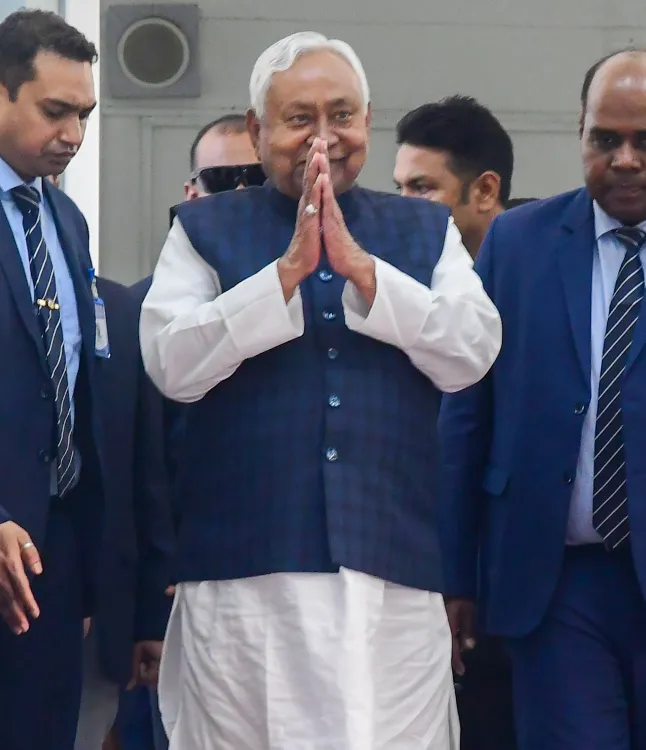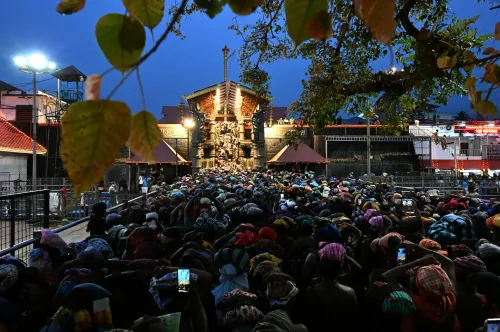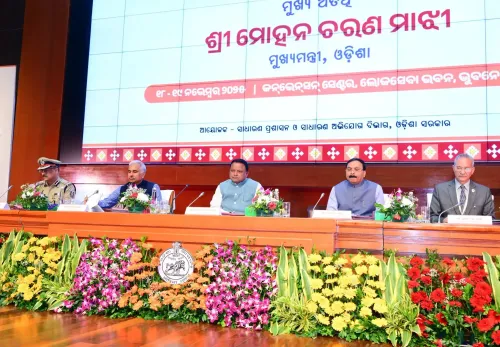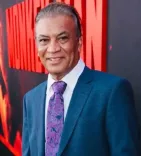Will Nitish Kumar Take Oath as CM for the Tenth Time?

Synopsis
Key Takeaways
- Nitish Kumar set to take oath for his tenth term as Chief Minister.
- Prime Minister Modi and other top leaders to attend the event.
- The ceremony is expected to draw over three lakh attendees.
- Significant political alliances reaffirmed with Kumar's leadership.
- Security arrangements have been enhanced to ensure a smooth event.
Patna, Nov 20 (NationPress) JD(U) leader Nitish Kumar will officially take the oath as the Chief Minister at Gandhi Maidan on Thursday at 11:30 a.m., marking his tenth tenure in this esteemed position. Prime Minister Narendra Modi is set to participate in the ceremony alongside Chief Ministers from various NDA-governed states. This event, hosted at the historic Gandhi Maidan, is expected to be one of the most significant political gatherings of recent times.
In addition to PM Modi, prominent figures such as Home Minister Amit Shah, Defence Minister Rajnath Singh, BJP National President J.P. Nadda, Uttar Pradesh Chief Minister Yogi Adityanath, and Maharashtra Chief Minister Devendra Fadnavis will also be present. Their attendance highlights the political importance of Nitish Kumar’s renewed mandate and the unified strength of the NDA in Bihar.
Comprehensive security measures have been implemented, anticipating more than three lakh attendees. The local administration has increased police presence, installed surveillance systems, and set up emergency medical units to guarantee the event runs smoothly.
On Wednesday, Nitish Kumar tendered his resignation as outgoing Chief Minister to Governor Arif Mohammad Khan, facilitating the formation of a new government. He was joined by Union Minister Chirag Paswan, RLM chief Upendra Kushwaha, and Uttar Pradesh Deputy Chief Minister Keshav Prasad Maurya during this visit.
Kumar was officially designated as the leader of the NDA legislative party during a meeting with the newly elected MLAs. Senior leader Samrat Choudhary has been appointed as the BJP legislative party leader, with Vijay Kumar Sinha as the deputy leader. Keshav Prasad Maurya, serving as the BJP’s central observer for this selection, was instrumental during the discussions.
Numerous JD(U) leaders are anticipated to be included in the new Cabinet. Potential candidates include Bijendra Prasad Yadav, Vijay Kumar Choudhary, Shrawan Kumar, Sunil Kumar, Lesi Singh, Sheila Mandal, Madan Sahni, Ratnesh Sada, Mohammad Zama Khan, Jayant Raj, Umesh Singh Kushwaha, and Ashok Choudhary. On the BJP side, leaders likely to remain in ministerial positions include Samrat Choudhary, Prem Kumar, Mangal Pandey, Vijay Kumar Sinha, Nitish Mishra, Renu Devi, Jibesh Kumar, Neeraj Kumar Singh, Janak Ram, Hari Sahni, Kedar Prasad Gupta, Surendra Mehta, Santosh Kumar Singh, Sunil Kumar, and Motil Lal Prasad.
Nitish Kumar's political career spans over four decades, characterized by significant alliances, bold choices, and a reputation for strategic adaptability. He began with the Janata Dal, winning his first Assembly election in 1985. Initially, he collaborated closely with Lalu Prasad Yadav, supporting him as the Leader of Opposition in 1989. However, their partnership began to erode as Nitish and several allies grew increasingly dissatisfied with Lalu's centralized control.
In 1994, Nitish played a critical yet understated role in one of the first significant revolts against Lalu Prasad. A faction of 14 MPs, publicly led by George Fernandes but strategically driven by Nitish, split away to form the Janata Dal (George). This group eventually evolved into the Samata Party, marking Nitish Kumar’s first definitive political break from Lalu and his initial endeavor to carve an independent political identity.
His next pivotal transition occurred in 1996, when he allied with the BJP, initiating a long and often tumultuous collaboration. His capabilities and administrative expertise earned him significant ministerial roles in the Atal Bihari Vajpayee-led NDA government between 1998 and 2004, particularly as Railway Minister, where he was widely recognized for implementing various reforms.
Nitish’s first brief term as Chief Minister occurred in 2000, supported by the BJP. However, his government collapsed within a week due to insufficient support. He made a robust return in 2005, ending Lalu Prasad Yadav’s 15-year reign and initiating what many analysts refer to as Bihar’s “reconstruction era”. For nearly a decade, Nitish Kumar governed with little political opposition.
This stability was disrupted in 2013, when Nitish severed ties with the BJP following PM Narendra Modi's nomination as the party’s prime ministerial candidate. This decision was portrayed as an ideological stance yet led to political instability and a decline in the JD(U)'s influence within the state.
In a significant comeback in 2015, Nitish rejoined Lalu Prasad Yadav to establish the Mahagathbandhan, a grand alliance that defeated the BJP and restored him to power. However, this renewed partnership was again short-lived. In 2017, citing corruption charges within the coalition, Nitish abruptly exited the alliance and returned to the BJP-led NDA, earning a national reputation for his readiness to make sudden political shifts.
In 2022, claiming the BJP aimed to fracture the JD(U), he left the NDA once more and rejoined the Mahagathbandhan. However, this chapter lasted only two years. As the 2024 General Elections approached, Nitish again aligned with the NDA, a move criticized as predictable by opponents but praised as pragmatic by supporters.
As of 2025, his political strategy seems to have succeeded once more. With his alliance firmly established and renewed electoral backing, Nitish Kumar is poised to take the oath as Chief Minister for the tenth time, solidifying his position as one of India’s most enduring and unpredictable political figures.









